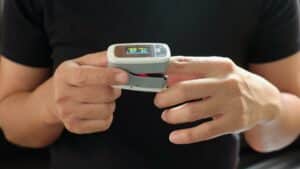If you have a condition such as chronic obstructive pulmonary disease (COPD) or pulmonary fibrosis, chances are that you might have a prescription for supplemental oxygen.
Supplemental oxygen has shown to be beneficial for many people with chronic lung disease by improving exercise tolerance and breathlessness during exertion.
Liquid oxygen, also called LOX, is different from concentrated or “regular” oxygen.
Concentrated oxygen tanks can be bulky and difficult to carry around, which is why some people choose to use smaller liquid oxygen tanks.
Let’s take a deeper look into what liquid oxygen is and weigh the pros and cons.
What is Liquid Oxygen?
Concentrated oxygen is oxygen in gas form, whereas liquid oxygen is oxygen that has been compressed into liquid form. That’s the major difference between the two.
There are other smaller differences, and the type of oxygen tank you choose will depend on your preferences.
Concentrated oxygen tanks are much larger than liquid oxygen tanks.
This is because when oxygen converts from a liquid to gas, it expands 860 times!
To convert oxygen from gas to liquid, it must be cooled by at least -297 degrees Fahrenheit, or -183 degrees centigrade.
Which is Better? Concentrated or Liquid Oxygen?
A study published in Thorax respiratory medicine journal took a look at liquid oxygen versus concentrated oxygen for portable use. Liquid oxygen came out slightly ahead.
The study reports: “The longer duration of liquid oxygen supply enables patients to spend more time using portable oxygen and going out of the house.”
Here’s a breakdown of the other findings from the study:
- All patients’ arterial oxygen tension values when they were breathing liquid oxygen and gaseous oxygen were similar
- There were no significant differences between the distance walked in the baseline walk test and the walk with liquid or gaseous oxygen
- The level of breathlessness also appeared to be similar for both types of oxygen after the two walking tests
- The baseline walking distance was greater after the eight weeks spent using liquid oxygen than at the initial baseline walk
- There was no significant difference in walking distance after eight weeks of gaseous oxygen
- There were no significant changes in spirometric values or arterial blood gas tensions throughout the duration of the study
- Patients using liquid oxygen left the house on an average of 19.5 hours a week, while patients using gaseous oxygen only left the house an average of 15.5 hours a week
- Of the 15 patients tested in the study, 11 preferred the liquid oxygen because it lasted longer, and carrying and filling it were both easier
Pros of Using Liquid Oxygen
Liquid oxygen takes up less space than oxygen in its gas form, making it easier and lighter to carry around. Not only that, it also can be stored at a much lower pressure.
This makes liquid oxygen tanks safer than concentrated oxygen cylinders under high pressure.
Liquid oxygen portable tanks are filled from reservoirs that can be kept in the home. They are easier to fill than concentrated oxygen tanks.
Additionally, liquid oxygen lasts longer than concentrated oxygen. In fact, a small amount of liquid oxygen can last a full day, making it a great choice to take with you when you leave the house.
Cons of Using Liquid Oxygen
You have to keep large containers filled with oxygen in your home to frequently fill the smaller, portable tank.
This not only takes up space in your home; additionally, the recurring oxygen deliveries can get pricey.
Another important thing to note is that liquid oxygen needs to be used within a week or two; otherwise, it will evaporate.
Liquid oxygen is often used for more hours a week than concentrated oxygen, meaning you will be wearing your oxygen more.
Some users have reported that the process of using liquid oxygen equipment is confusing and difficult to remember.
Who Uses Liquid Oxygen?
Convenience and efficiency are the two major deciding factors when choosing between liquid or concentrated oxygen. Speak with your primary care physician about both options, and he or she will help you arrive at a decision that best suits your lifestyle.

Christine Kingsley, APRN is the Health and Wellness Director at the Lung Institute where she focuses on providing helpful online resources for people looking for information on various lung diseases, breathing exercises, and healthy lifestyle choices. She advocates for holistic care that involves working with your doctor to explore all options including traditional and alternative care while focusing on diet and exercise as proactive measures.









